|
A horse/zebra hybrid foal at the Rothschild Zoological Museum, Tring,
England. |
|
HYBRID EQUINES - HORSE/PONY X ZEBRA |
Equid (horse, donkey, zebra) hybrids are well known and some are bred commercially. The generic term for a zebra hybrid with a horse, pony, donkey or ass is a zebroid. The generic term for a hybrid of a zebra with any type of donkey or ass is a zebrass.
The usual naming convention for hybrids is a "portmanteau word" comprising first part of male parent's name + second part of female parent's name
|
Father |
Mother |
Offspring |
|
Zebra |
Horse |
Zorse, Golden zebra, Zebra mule, Zebrule |
|
Zebra |
Pony |
Zony |
|
Zebra |
Shetland Pony |
Zetland |
|
Horse |
Zebra |
Hebra |
|
A horse/zebra hybrid foal at the Rothschild Zoological Museum, Tring,
England. |
Zebras that are hand-reared or reared with domestic horses or donkeys can become tame enough to be led, ridden or used as draught animals. Those raised with horses or donkeys may prefer to mate with horses or donkeys rather than with zebras.
See the main index for the detaied page on Zebrule/Zebrula breeding experiments.
A widely circulated report, published in May 1903, writes: "That entirely new species of animals may be created is demonstrated by the latest achievements of the world s greatest animal hunter, Carl Hagenbeck. On his animal ranch near Hamburg, Germany, Hagenbeck has for some time past been devoting himself to the creating of new species of animals and birds. He has obtained new varieties of deer and mules and wonderful crosses between the zebra and the horse. [. . .] Probably the furthest developed of the new species, of animals he is creating is the cross between the zebra and the horse. A number of these are at his depot in Hamburg, and it is not an uncommon sight to see him taking a drive behind two of these strange horses. The characteristic of these animals is that they possess the zebra s body and the horse s head, and are as large as mules. The aim has been to obtain a stronger and better blood than that possessed by the existing equine breeds. At present Hagenbeck has six zebra-horses broken to harness. He has found them possessed of greater endurance and strength than horses of their weight, and seemingly possessed of greater intelligence." According to the Croydon Chronicle and East Surrey Advertiser, 19th December 1903 (among many others): Scientific Cross-breedings. Carl Hagenbeck, of Hamburg, the well-known wild animal dealer, [. . .] is trying to introduce the zebrule, or hybrid horse and zebra into the German Army in place of mules. We know that the zebrules are being tried in the Indian Army.
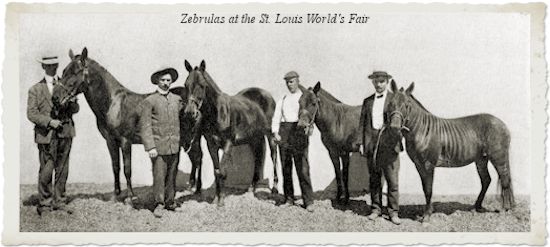
NEW DRAFT ANIMAL DOOMS ARMY MULE. CROSS BETWEEN HORSE AND ZEBRA IS SUPERIOR. DOES NOT CONTRACT DISEASE.
More Lively Than the Animal That Provokes Cussing and Cannot Be Less Intelligent. (Various, August 1903)
The days of the mule are numbered. Within the next few centuries his melodious voice will have been stilled forever. This is the prophecy of United States Consul General Richard Guenther, at Frankfort, Germany, who sends a report to the state department on the chances of the zebrula, a cross between the horse and zebra, superceding the mule. He says of the qualifications of the zebrula:
German papers contend that it has been demonstrated that the mule, the cross between the horse and donkey, is inferior to the cross between horse and zebra. Formerly the opinion prevailed that the zebra was almost extinct. The opening up of Africa, particularly the eastern part, reveals these fine animals in large numbers. Compared with horses and cattle, they possess peculiar advantages, as they are immune against the very dangerous horse disease of Africa, and also against the deadly tztze. The question was therefore raised whether the zebra could not take the place of the mule, commonly used in the tropics. The greatest credit with reference to the solution of this problem is due to Professor Cossar Ewart, who has been trying since 1895 to produce crosses between horses and zebras, with a view to developing an animal superior in every respect to the mule. Professor Ewart produced crosses from mares of different breeds and zebra stallions of the burchell kind. The offspring is called zebrula, and on account of its form and general bodily condition, especially the hardness of the hoofs, is specially adapted for all transport work heretofore performed by mules. The zebrula is much livelier than the mule and at least as intelligent. The zebra stripes are often well preserved, while the undertone of the skin is generally that of the mother. A full grown zebrula is fourteen hands high and the girdle circumference about 160 centimeters (sixty-three inches). The experiments so far have been so successful that it is predicted that the zebrula during the present century will completely supercede the mule.
Other newspapers of the time wrote "The days of the mule are numbered, comes the word from Germany, where a new animal, the Zebrula, has been evolved to take the place of the gentle-eyed, melodious-voiced and hard- hoofed little animal. The new animat1 is the result of a cross between the horse and a zebra. The nomenclature of horseology would indicate that a better name for the new quadruped would-be the zehorska."
A report from the November 25th, 1904 edition of the Olsburg Gazette mentions the zebrulas at the World s Fair: The Zebrula. A new breed of horseflesh has come into public notice, namely, the Zebrula. Some of these animals are being shown at the World s Fair. They originated in Africa from a cross of the Zebra stallion and the horse mare. They are said to be highly regarded in South Africa, where they are valuable on account of not being affected by the bite of the tsetse fly, which is sure death to the horse or donkey. Breeders in South Russia, in England and Germany have taken up the breeding of these animals. They are said to be hardier than the mule or horse. The Zebra is known to be a very wild and swift animal and for a long time it was found impossible to make him useful to man on account of his wildness. The crossing has taken some of the wildness out of his progeny. The name given to the progeny is Zebrula. It is likely that we will soon have a good many varieties of the Zebrula, as there are two species of zebras, those inhabiting the mountains and those inhabiting the plains, and the crossing of these in various ways should give a great variety of markings and other conformations.
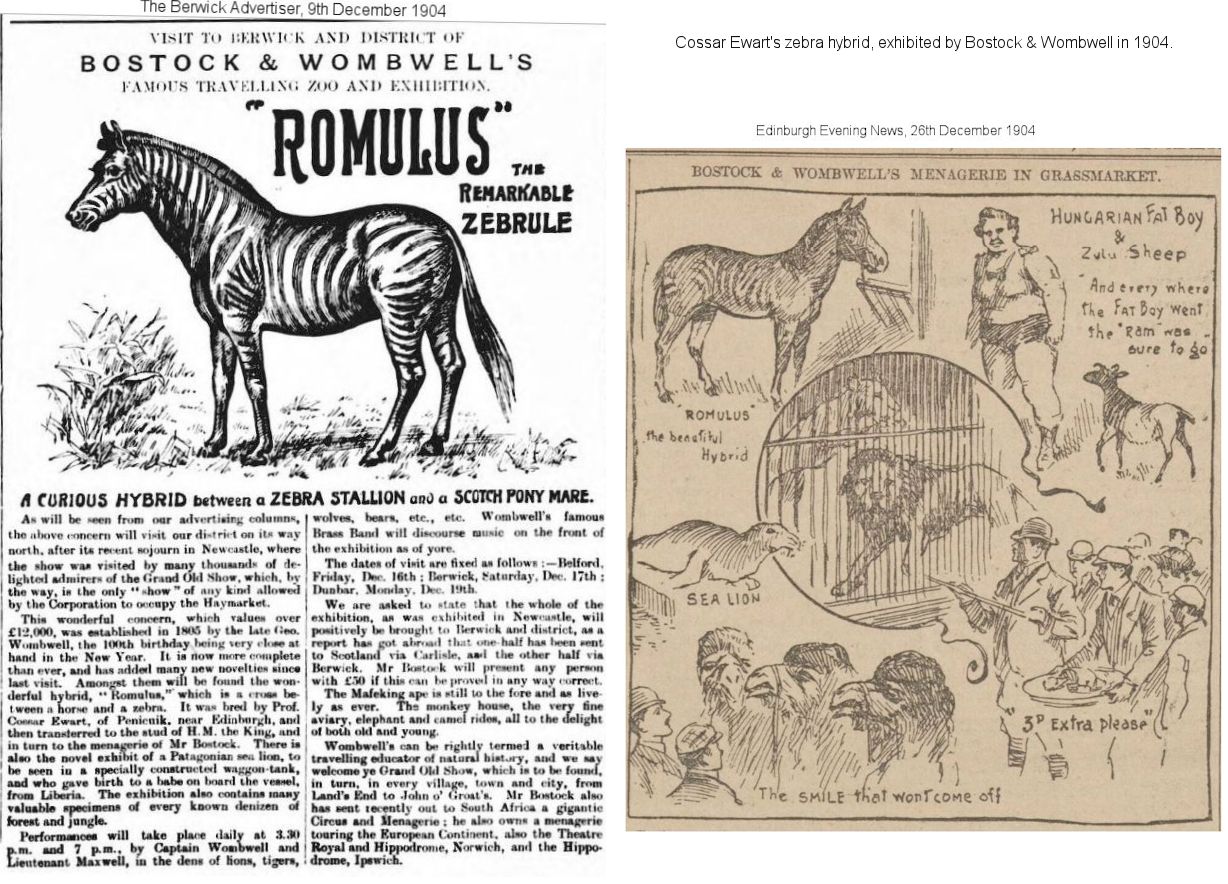
On January 27th, 1905, The Times Dispatched asked Will Zebrulas Come Here? [American] Government May Experiment With New Zebra Horse Cross. It is understood that the government has under consideration the importance of zebras for the purpose of experimental breeding with the horse. The Agricultural Department has been asked to take up this work, but as Uncle James Wilson Is pretty well acquainted with the American mule and his good qualities, it is not sure that he will spend much time or money on the new breed. The hybrid between the horse and the zebra is a striped animal with great speed and endurance. Germany has been experimenting with this cross. for several years and has tested its value in war with results that were very encouraging. It is said of the zebrula that it is as gentle as a horse, in this respect differing very much from the zebra. It is stronger than a mule and entirely immune from certain diseases which are pretty certain to attack horses and frequently with fata) results when imported into certain parts of Africa. As soon as the German Government were satisfied with the success of this line of crossing, it at once established a breeding station in its African possessions. At this station much attention in being given to the breeding of zebrulas, and these are now regularly used in handling heavy ordnance, as, for instance, mountain batteries of the colonial service. They are also being used as mounts for officers and men, and for draught ' purposes in various ways.
Later on, The Cincinnati Enquirer of May 1st, 1905 wrote: Three Zebrulas Added To the Curiosities of the Cincinnati Zoological Garden. Three zebrulas have been received at the zoo from the Hagenbeck Company at Hamburg, Germany. The animals have been in this country for some time, and were a part of the big collection of wild animals which was exhibited at the St. Louis World s Fair by Hagenbeck. The zebrula is a hybrid animai, which is secured by crossing the zebra with either a donkey or a horse. One of the zebrulas received here is a cross with a horse, and the other two are crossed with donkeys. The zebrulas are bred by the German army for experimental purposes for use in Africa. The zebra has a hide which can resist the insects and flies, and by crossing them with horses the Germans hoped to produce an animal which had the endurance of the horse and those qualities of a zebra which would allow it to be used for domestic purposes in Africa. The hybrid was called the zebrula as it is purely an artificial animal."
Ultimately, the zebrula was to become a circus curiosity as this cutting from The Kingsport Times of August 20, 1925 indicates: "ZEBRAS AND ZEBRULAS DO TRICKS AT WILL OF CHRISTY'S TRAINERS. For the first time in the history of wild animal training zebras and zebrulas have been taught to perform tricks and obey the will of their trainer. Some fine specimens of these animals are with Christy Bros, trained wild animal show, which will exhibit in Kingsport on Monday, September 14. The striped equine has always been the stumbling block in the paths of educators and trainers of beasts and animals. Many of them after herculean and patient endeavor have given up in disgust and consigned the convict coated animal to a remote and disagreeable locality, acknowledging that he was beyond all human understanding. Christy Bros, trainers for many years concurred in this belief, but heroic perseverance was finally and justly rewarded. These circus kings now have with their great show zebras that give performances which include everything done by the best trick horses. Interesting in this connection is the appearance and presentation at the same time of several zebrulas, or equine hybrids, the only ones of their kind, produced by scientific crossing of full blooded zebras and Kentucky thoroughbred horses."
Here we have an account of the hybrid from The Elyria Reporter on August 22nd, 1905: To experiment With Zebrula. Zebrula, .a newly coined word. Is applied lo a peculiar appearing animal. The zebrula is a cross between a full-blooded, vicious zebra and an American horse. The zebra, as students of natural history are informed, is the hardest of all four-footed, hay-eating animals to handle. It is more treacherous than either the lion or tiger, and is ten times more lively, when it comes to kicking, than the well-known Missouri mule. The zebrula does not Inherit these bad qualities from his sire s side. He looks like a zebra about the head and has dull brown stripes that show indistinctly int [sic] he still duller brown of the hair, which is very soft and silky. A full-blood zebra possesses bright, black and white stripes in conformation the zebrula follows the type of the American horse, and from the infusion of the latter s blood. Its temper is normal, as it were, and it displays the many good traits of the horse. English army officers have become greatly interested in the zebrula and have induced the government to request Mr. Hagenbeck to breed at least a dozen of them and send them to South Africa, for experimental purposes. The officers believe the zebrula will stand the South African climate better and do considerably more work than either the full-blooded mule or horse.
From The evening News, September 7th, 1922: Science is just now Interested In hybrids of the zebra stock. There is a stocky-built faintly-striped zebrula at the Zoo, a cross between a zebra and a Shetland pony. In Southern Indiana the zebra has been successfully mated with Arabia mares, producing the zebroid, a tough but docile beast of burden. One advantage expected of this cross Is the longevity that the sire may be able to confer on his progeny. In his native Africa he sometimes reaches 75 years, and if his hybrid American offspring can carry their vigor into fifty years, this would be more than double the horse s expectancy of life. (The claim of such longevity in zebras was incorrect)
The Daily Courier of December 7th, 1936, mentioned the zebrula in brief: Mule, Jennet and Zebrula. Of animals which owe their existence to man the mule and the jennet are the oldest examples, and no one can deny that the mule is a most useful creature Hardy as a donkey, strong as a horse, surefooted and tireless, there is nothing like it for rough country traveling Its success caused the production of the zebrula which is a cross between the horse and zebra. The zebrula is as strong as a mule, but livelier and even less liable to disease.
ZEBRA/HORSE, ZEBRA/PONY HYBRIDS
Zebras will hybridize in the wild with feral horses in South Africa and with wild asses in northeast Africa. When I was a child, I had some of Time Life books. If memory serves, one contained a photo of a mixed herd of zebra, wild horses and zebroids where the aggressive zebra stallions stole the horse mares from the feral herds in parts of South Africa. The horses arrived in the region with settlers and with the British and German armies. Some escaped and others were abandoned (due to the cost of returning them to Europe); being herd animals, they would have been attracted to zebra herds. Others fell prey to lions as they lacked the zebra s camouflage. The zebroid offspring, although they grew to adulthood and remained with zebra herds, were also vulnerable to predators and, being generally sterile, did not produce offspring of their own.
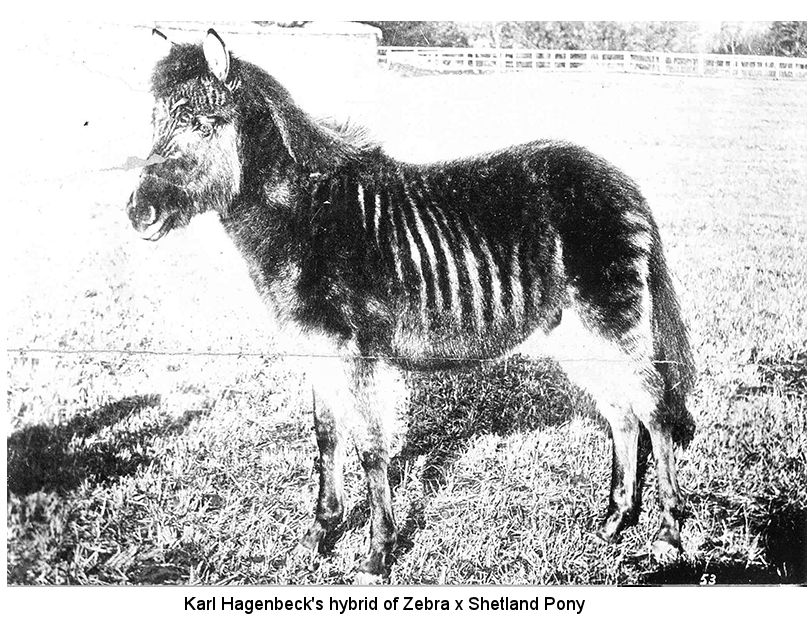
Zorses or zebrules are zebra stallion/horse hybrids and zonies are zebra stallion/pony hybrids. Zorses are sometimes called golden zebras due to dark stripes overlaying a chestnut background, though the colour depends on the colour of the horse parent. The zetland is a one off accidental zebra/Shetland pony hybrid. Zebroid is a blanket term for zebra/horse hybrids. Any of the zebra species can be used in breeding zebroids; the colour depends on the colour of the horse; usually there is clear striping on the legs, a dorsal stripe, striped face and less distinct stripes on the body; the somewhat donkey-like attributes of zebras result in a dorsal stripe, upright mane without a forelock and large ears. Another term for zebra hybrids is zebra mule since zebra stallions (which are hand-raised or fostered on a horse mare) are used in preference to zebra mares. Zebra hinnies are rarely found. Zebroid and zebrass males are generally sterile. Although wild animals, zebras which are hand-reared or reared with domestic horses can become tame enough to be led, ridden or used as draught animals.
Piebald zorses are produced when a zebra is crossed to a piebald horse. Stripes are visible on the colored areas of the coat. The white patches form a startling contrast with these striped patches. A hybrid called "Eclyse" was bred in Germany in 2007 from a zebra mare and piebald or skewbald horse stallion (piebald = black-and-white, skewbald = any-other -colour-and-white e.g. brown/bay/chestnut with white). Pied zorses are not commonly bred.
In "Origin of Species" (1859) Charles Darwin wrote: "In Lord Moreton's famous hybrid from a chestnut mare and male quagga, the hybrid, and even the pure offspring subsequently produced from the mare by a black Arabian sire, were much more plainly barred across the legs than is even the pure quagga..
In his "The Variation Of Animals And Plants Under Domestication", Darwin wrote: "I have seen, in the British Museum, a hybrid from the ass and zebra dappled on its hinder quarters. [...] Many years ago I saw in the Zoological Gardens a curious triple hybrid, from a bay mare, by a hybrid from a male ass and female zebra". and further described Moreton's hybrid; In the famous hybrid bred by Lord Morton ('Philosoph. Transact.' 1821 page 20.) from a chestnut, nearly purely-bred, Arabian mare, by a male quagga, the stripes were "more strongly defined and darker than those on the legs of "the quagga." The mare was subsequently put to a black Arabian horse, and bore two colts, both [...] plainly striped on the legs, and one of them likewise had stripes on the neck and body. In "Darwinism An Exposition Of The Theory Of Natural Selection With Some Of Its Applications" (1889), Alfred Russel Wallace commented: "Crosses between the two species of zebra, or even between the zebra and the quagga, or the quagga and the ass, might have led to a very different result."
Raymond Hook of Nanyuki, Kenya, is claimed to have bred the first zebroids by crossing a Grevy's zebra stallion with domestic mares (date unknown?). The hybrids had Grevy-like narrow stripes and a tufted tail, but were more horselike in conformation and color. The strong, sure-footed, docile and mulelike zebroids were used as pack animals by climbers on Mount Kenya's lower slopes. Grevy's zebra has also been crossed with donkey mares. Carl Hagenbeck produced zebrules (zebra/pony hybrids) at his Tierpark in Hamburg. These had dark bodies and faintly visible stripes.
|
|
|
|
See the main index for the detaied page on Professor Cossar Ewart's zebra/horse breeding experiments.
In "Anomalies and Curiosities of Medicine" by George M Gould and Walter L Pyle (1896) wrote: The influence of the paternal seed on the physical and mental constitution of the child is well known. To designate this condition, Telegony is the Word that was coined by Weismann in his "Das Keimplasma," and he defines it as "Infection of the Germ," and, at another time, as " Those doubtful instances in which the offspring is said to resemble, not the father, but an early mate of the mother," - or, in other words, the alleged influence of a previous sire on the progeny produced by a subsequent one from the same mother. In a systematic discussion of telegony before the Royal Medical Society, Edinburgh, on March 1, 1895, Brunton Blaikie, as a means of making the definition of telegony plainer by practical example, prefaced his remarks by citing the classic example which first drew the attention of the modern scientific world to this phenomenon. The facts of this case were communicated in a letter from the Earl of Morton to the President of the Royal Society in 1821, and were as follows:
In the year 1815 Lord Morton put a male quagga [a type of zebra] to a young chestnut mare of seven eighths Arabian blood, which had never before been bred from. The result was a female hybrid which resembled both parents. He now sold the mare to Sir Gore Ousley, who two years after she bore the hybrid put her to a black Arabian horse. During the two following years she had two foals which Lord Morton thus describes: " They have the character of the Arabian breed as decidedly as can be expected when fifteen sixteenths of the blood are Arabian, and they are fine specimens of the breed; but both in their color and in the hair of their manes they have a striking resemblance to the quagga. Their color is bay, marked more or less like the quagga in a darker tint. Both are distinguished by the dark line along the ridge of the back, the dark stripes across the forehand and the dark bars across the back part of the legs." The President of the Royal Society saw the foals and verified Lord Morton's statement.
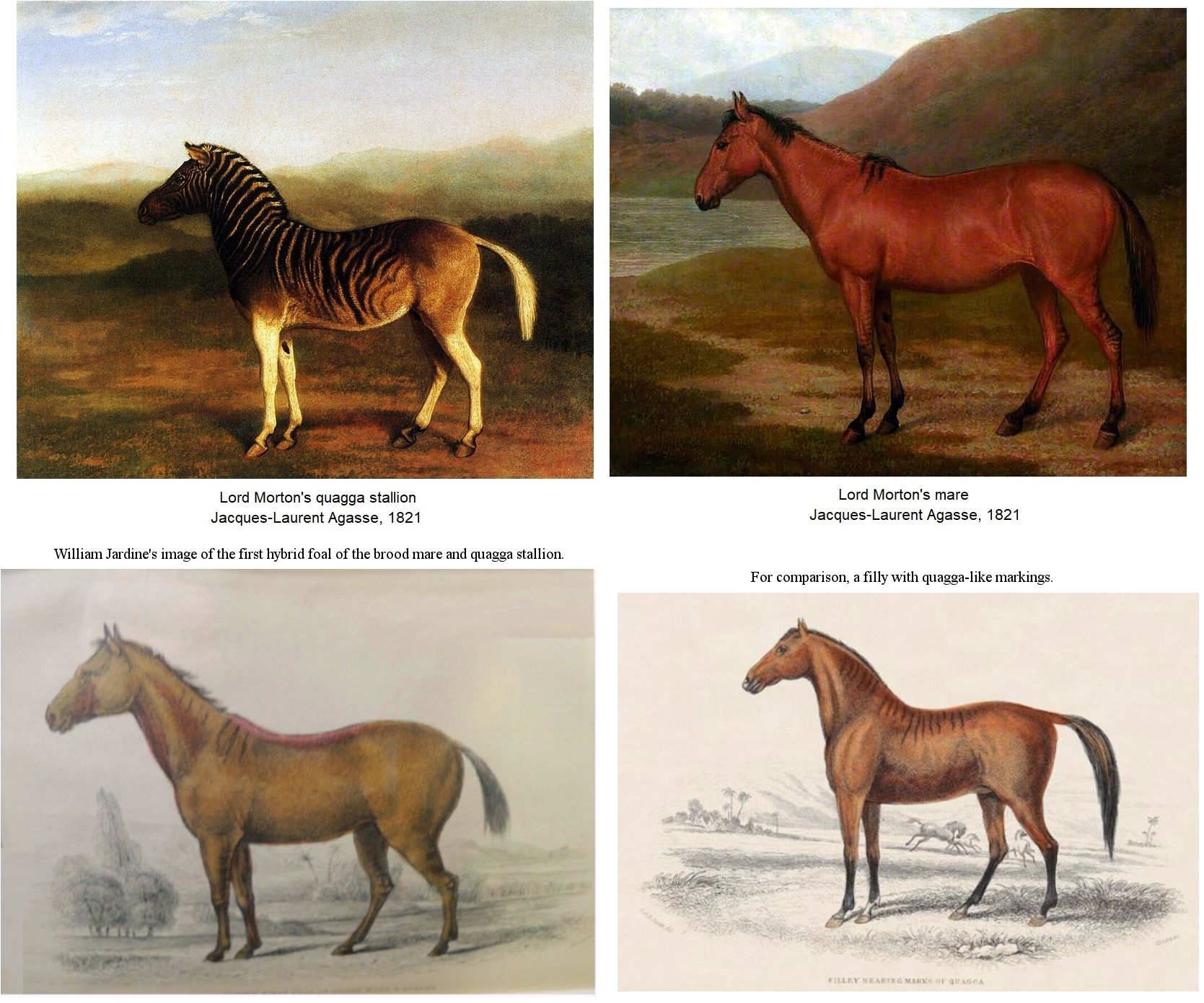
Cossar Ewart, Professor of Natural History at Edinburgh (1882-1927) and a keen geneticist, crossed a zebra stallion with pony mares in order to disprove telegony, or paternal impression, a common theory of inheritance at the time. Cossar Ewart found that zebra-horse hybrids were brown with faint stripes. When the same mares were subsequently mated with a pony, the resulting foals showed none of the markings or temperamental characteristics of a zebra. He completely undermined Lord Morton's case by pointing out that similar bandings occur naturally, without crossing, in certain breeds of horses, notably a Norwegian breed; and by breeding many zebra hybrids the progeny of a great variety of virgin horse and pony mares, followed by foals from the same mares by an Arab stallion not one of which showed any marking or other characteristic which could be traced to the zebra! Cossar Ewart found that in male zebra-hybrids the sexual cells were immature and the sperm were abnormal, however the ovaries of female zebra-hybrids appeared similar to those of a normal mare or female zebra. As well as disproving paternal impression, he wanted to produce a more resilient draught animal for South Africa; one less subject to local diseases and more tractable than a mule.

From Bell's Weekly Messenger, 11th December 1871, page 11, there is a report on the meeting of the Central Farmer's Club where a paper by Reginald Orton was mentioned, containing this excerpt: "Many you have perhaps heard of Lord Morton's curious experiment with the Quagga; he put a Quagga stallion to a thorough-bred chestnut mare, and the produce was a Quagga mule with stripes, and many characteristics of the male. The season he put the mare toa black Arab horse, and to the astonishment of his lordship, she produced a foal bearing strong marks of the Quagga, and this effect was visible for three generations from a blood stallion. There is a similar case recorded in the transactions of the Royal Society, where a mare of Sir George Ousley s was put to a Zebra, and the produce was striped like the sire; and she was next year served by a blood horse, and the foal had the zebra stripes, and the same result again followed the next year. It therefore would appear that a female once impregnated retains certain traces of the male, which remains by her for an undefined period."
Gos de Voogt wrote, in Our Domestic Animals, their habits, intelligence and usefulness (translated from the French by Katherine P. Wormeley; edited for America by Charles William Burkett; Ginn and Co.; Boston; 1907): Lately a Scotch naturalist, J. C. Ewarts, who has made himself a name in this domain, mated a zebra stallion, named Matopes, with a mare from one of the Scotch islands. The product was a foal which received the name of Romulus, the new race being called zebrules,Sir John, a colt, and the fillies Bunda and Black Agnes, which were both sold to Hamburg ; the English government then bought them and sent them to India, where they were trained for service in a mountain battery. In shape the zebroids are a cross between the horse and the zebra. Romulus, born in 1896, derived from his father only very indistinct stripes, while Sir John has them more clearly defined. These zebroids are strong, manageable, and easy to train both for saddle and harness ; it is hoped that they have inherited the zebra's immunity from equine diseases.
|
|
In "The Science of Life" (c 1929) by H G Wells, J Huxley and GP Wells, the authors wrote "To-day it is possible to assert without any question that telegony is a mere fable, which could only have gained ground in the days when men were ignorant of the true mechanism of fertilization and reproduction. The supposed instances of telegony which are constantly being reported even to-day, invariably. Perhaps the most famous example is that of Lord Morton's mare. The mare, a pure Arabian, was mated with a zebra stallion, and produced a hybrid foal. On two later occasions, she was bred to a black Arab stallion, and gave birth to two further foals. These had legs which were striped even more definitely than those of the hybrid foal or the zebra sire himself, and one had some stripes on parts of the neck also. In addition, they had a stiff mane of very zebra-like appearance. Darwin himself accepted the evidence as sufficient proof of telegony. But when definitely planned and long-continued experiments were made, the proof escaped. Cossar Ewart, for instance, made a number of horse and zebra crosses to test the validity of the belief. When mares previously bred to zebras were afterwards mated with horse stallions, their colts were often without the least trace of zebra characters. In other cases, colts with some degree of striping were produced. But one mare gave birth to a striped colt as a result of her first mating, which was with a horse stallion ; while two later matings with other stallions, made after she had been successfully mated once and three times respectively with a zebra, gave unstriped offspring. In other cases, when striped colts were born to a mare and stallion after the mare had been previously mated to a zebra, Ewart took other mares, closely related to the first, bred them to the same Arabian stallion without having mated them previously with a zebra - and they, too, produced striped foals. In short, the production of striping (and also of erect mane) in foals is not a very uncommon occurrence in horses; it may appear whether previous impregnation by a zebra has taken place or not. The stripes of Lord Morton's foals were a mere coincidence, well illustrating the danger of drawing conclusions from single and therefore possibly exceptional cases, and the need for systematic and repeated experiments."
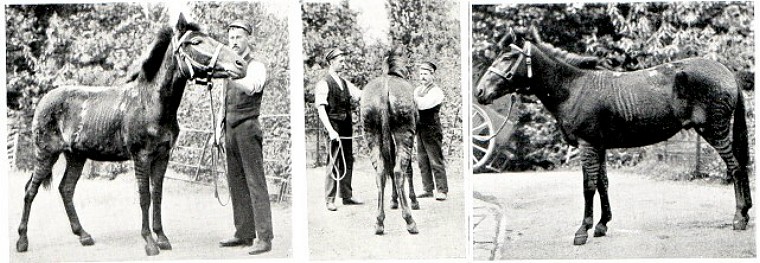
Above: The King's Hybrid (1902). This is the animal that Hammerton later described in 1930.
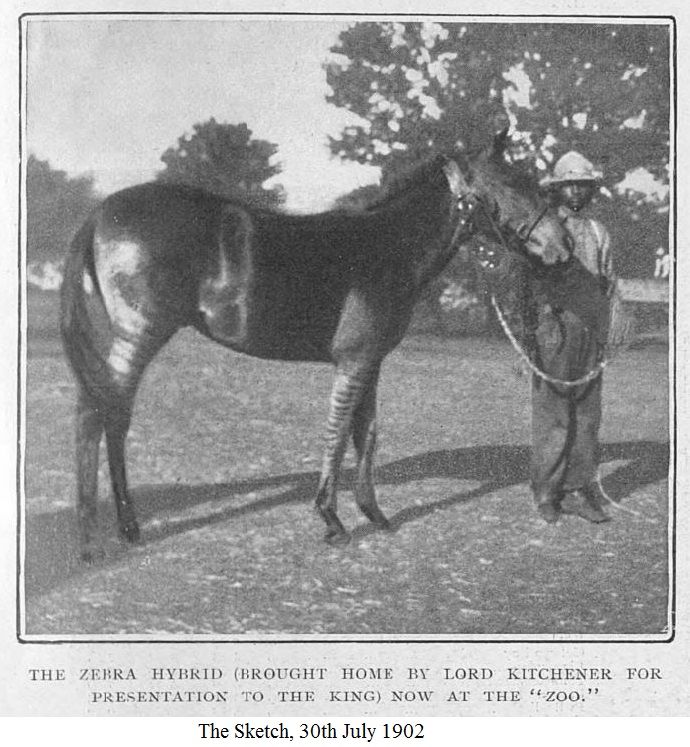
A REMARKABLE ZEBRA HYBRID. (The Sketch, 30th July 1902) The accompanying photograph of a remarkable zebra hybrid which Lord Kitchener brought home for presentation to the King is of peculiar interest. The animal (which, properly speaking, should be described as a quagga," being a cross between a zebra and a pony) was bought as a yearling in South Africa by Captain A. C. Webb, of the Johannesburg Remount Depot, who, after training it to the saddle, sent it home by Lord Kitchener as a present to His Majesty. The quagga is an inch and a-quarter over thirteen hands the body-colour brown, lightening to bay on the head and legs, with very peculiar striping. The marks on the body and cheeks are almost vertical, the leg markings horizontal to the hocks, below which the colour is black, while the dorsal stripe tapers to the tail. The animal is very beautiful and shapely, strongly resembling a well-grown pony, with a quiet, easy temper. When first brought home by Lord Kitchener, it was quartered in the Royal Mews at Buckingham Palace, but, as the King has decided that so remarkable a hybrid specimen should find a place in the Zoological Gardens, it was taken to Regent's Park last week by two of the Royal grooms, who led it quietly through tire busy streets without attracting any attention. It occupies, for the present, a big loose-box in the Upper Yard in the Zoo," where it has apparently made itself quite at home and comfortable. From a scientific point of view, the new-comer is said to be one of the most remarkable animals that have come into the possession of the Society for many years. The photograph was taken at the Remount Depot at Johannesburg.
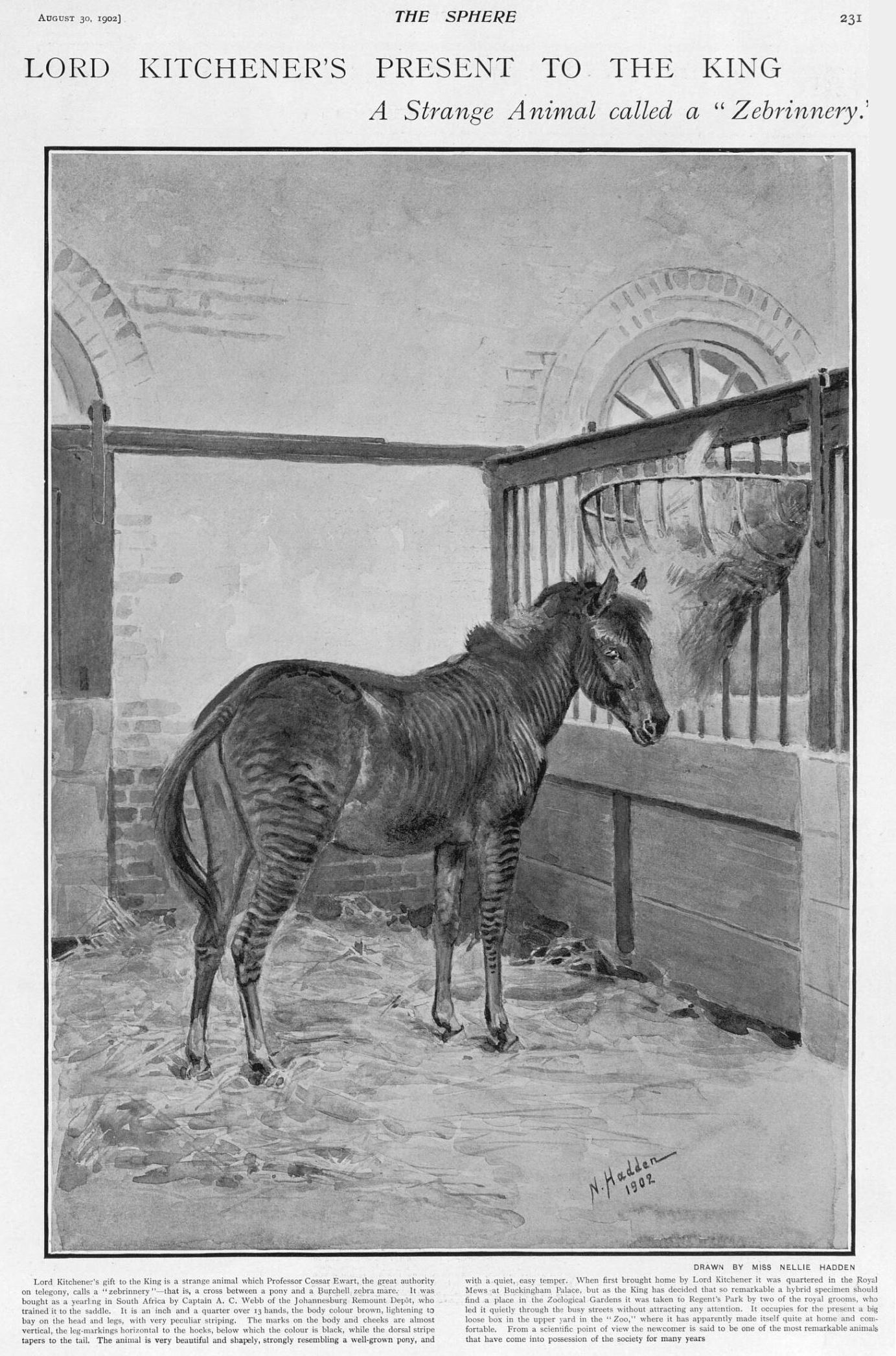
In "Animal Life and the World of Nature" (1902-1903), WP Dando (Fellow of the Zoological Society, London) writes: Much interest has been aroused at the Zoo by the presentation by His Majesty the King of a hybrid Zebra, a cross-breed between a stallion horse and a Burchell's zebra mare. This animal was sent over to England by Lord Kitchener, who discovered it among the remounts placed at his disposal in the Transvaal during the war. The zebra markings are fairly distinct on all four legs, also slightly across the loins and at the root of the tail, continuing a few inches up the centre of the buttocks. These markings (and the tail itself, which it will be noticed is more like a donkey's than a horse's) are the only characteristics of the zebra which are prominent, the animal lacking the erect mane and other distinguishing features. Since the animal has been in captivity he has become most ferocious and savage - no doubt from the want of proper exercise. By the courtesy of the Society's officials I was enabled to get my pictures in the yard adjoining the stables, the animal being securely held; and I took my position at a respectful distance."
|
In "Wonders of Animal Life" (1930), J A Hammerton, it noted that crosses were made between Chapman's zebras and a ponies during the South African War . |
In "Wonders of Animal Life" (1930) edited by J A Hammerton, it notes: During the South African War, an attempt was made by the Boers to evolve a new animal to supplement the supply available for transport work. A cross was obtained between a Chapman's zebra and a pony and a specimen was captured by the British and presented to King Edward VII by Lord Kitchener. The animal was produced chiefly for hauling guns. It was photographed by W S Berridge. WP Dando FZS, in the 1902/03 encyclopedia "Animal Life and the World of Nature" described the same hybrid as a cross with a Burchell's zebra.
McClintock noted that a Chapman's zebra stallion, kept by Friedrich von Falz-Fein at Askania-Nova in southern Russia actually preferred to mate with domestic mares rather than with a Chapman zebra mare. Eventually the stallion killed his zebra mate by biting her to death.
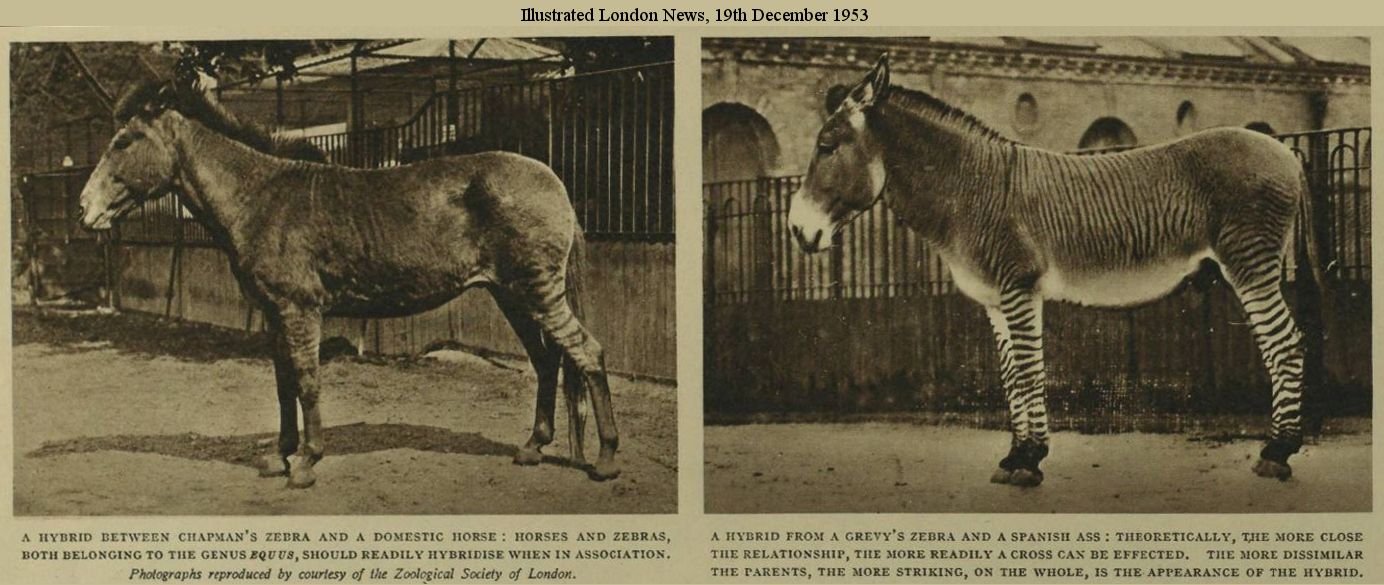
In Out of Africa , the African memoirs of Baroness Karen Blixen (1885-1962) published in 1937, Blixen writes: It is a much debated question whether it is possible to cross domestic animals with the game: many people have tried to create a type of small horse fitted to the country, by breeding from zebra and horses, though I myself have never seen such cross-breeds.
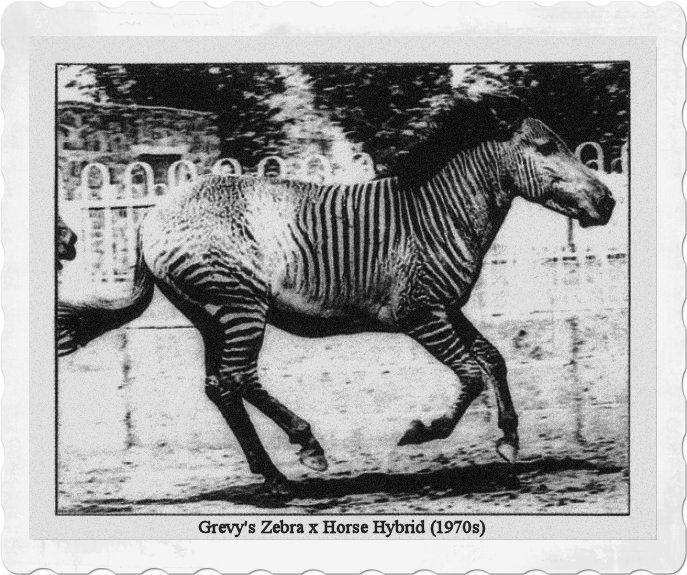
Today, zorses and zonies are relatively common. Zebra hybrids are considered better suited (through better temperament and more horse-like/donkey-like conformation) than pure zebras to being ridden or used for draught. They are resistant to some of the diseases that afflict horses and donkeys, hence they have been used use in Africa for trekking and draught. In the USA they are bred as riding and show animals, because of their interesting appearance. in Manila Zoo in 2011, a domestic stallion that found itself isolated by other horses, made itself part of the zoos zebra herd where it fathered a hebra .
ZORSE/ZONY COLOURS
Zebras are normally bred to solid colour horses/ponies to produce offspring with striping over the whole body. The interaction of chestnut and zebra striping gives rise to the alternative name "golden zebra". The striping pattern depends on the type of zebra used. When bred to a piebald (black-and-white) horse (US: piebald pinto) or to a skewbald (brown/bay/chestnut-and-white) horse (US: skewbald pinto) or to particoloured USAnian breeds known as "Paint" and "Appaloosa", the offspring have a mix of striped coloured areas and unstriped white areas. Grey horses are not used as the offspring will be grey, becoming white with age, albeit having the conformation of a zorse/zony.
DARWIN ON HYBRID EQUIDS
In "Origin of Species" (1859) Charles Darwin mentioned four coloured drawings of hybrids between the ass and zebra. He noted "In Lord Moreton's famous hybrid from a chestnut mare and male quagga, the hybrid, and even the pure offspring subsequently produced from the mare by a black Arabian sire, were much more plainly barred across the legs than is even the pure quagga. Lastly, and this is another most remarkable case, a hybrid has been figured by Dr. Gray (and he informs me that he knows of a second case) from the ass and the hemionus." Darwin described the latter hybrid in "The Variation Of Animals And Plants Under Domestication": The Equus indicus [onager] a hybrid, raised at Knowsley ('Gleanings from the Knowsley Menageries' by Dr. J.E. Gray.) from a female of this species by a male domestic ass, had all four legs transversely and conspicuously striped, had three short stripes on each shoulder and had even some zebra-like stripes on its face! Dr. Gray informs me that he has seen a second hybrid of the same parentage, similarly striped.
In his "The Variation Of Animals And Plants Under Domestication", Darwin wrote: "I have seen, in the British Museum, a hybrid from the ass and zebra dappled on its hinder quarters. [...] Many years ago I saw in the Zoological Gardens a curious triple hybrid, from a bay mare, by a hybrid from a male ass and female zebra. and further described Moreton's hybrid; In the famous hybrid bred by Lord Morton ('Philosoph. Transact.' 1821 page 20.) from a chestnut, nearly purely-bred, Arabian mare, by a male quagga, the stripes were "more strongly defined and darker than those on the legs of "the quagga." The mare was subsequently put to a black Arabian horse, and bore two colts, both [...] plainly striped on the legs, and one of them likewise had stripes on the neck and body.
In that book, Darwin concluded: "The ass has a prepotent power over the horse, so that both the mule and the hinny more resemble the ass than the horse; but that the prepotency runs more strongly in the male-ass than in the female, so that the mule, which is the offspring of the male-ass and mare, is more like an ass, than is the hinny, which is the offspring of the female-ass and stallion." In "The Variation Of Animals And Plants Under Domestication" Darwin elaborated: "Colin, who has given in his 'Traite Phys. Comp.' tome 2 pages 537-539, [...] is strongly of opinion that the ass preponderates in both crosses, but in an unequal degree. This is likewise the conclusion of Flourens, and of Bechstein in his 'Naturgeschichte Deutschlands' b. 1 s. 294. The tail of the hinny is much more like that of the horse than is the tail of the mule, and this is generally accounted for by the males of both species transmitting with greater power this part of their structure; but a compound hybrid which I saw in the Zoological Gardens, from a mare by a hybrid ass-zebra, closely resembled its mother in its tail.)"
In "Darwinism An Exposition Of The Theory Of Natural Selection With Some Of Its Applications" (1889), Alfred Russel Wallace commented: "Crosses between the two species of zebra, or even between the zebra and the quagga, or the quagga and the ass, might have led to a very different result."

Textual content is licensed under the GFDL.
|
BACK TO HYBRIDS & MUTANTS INDEX INDEX |